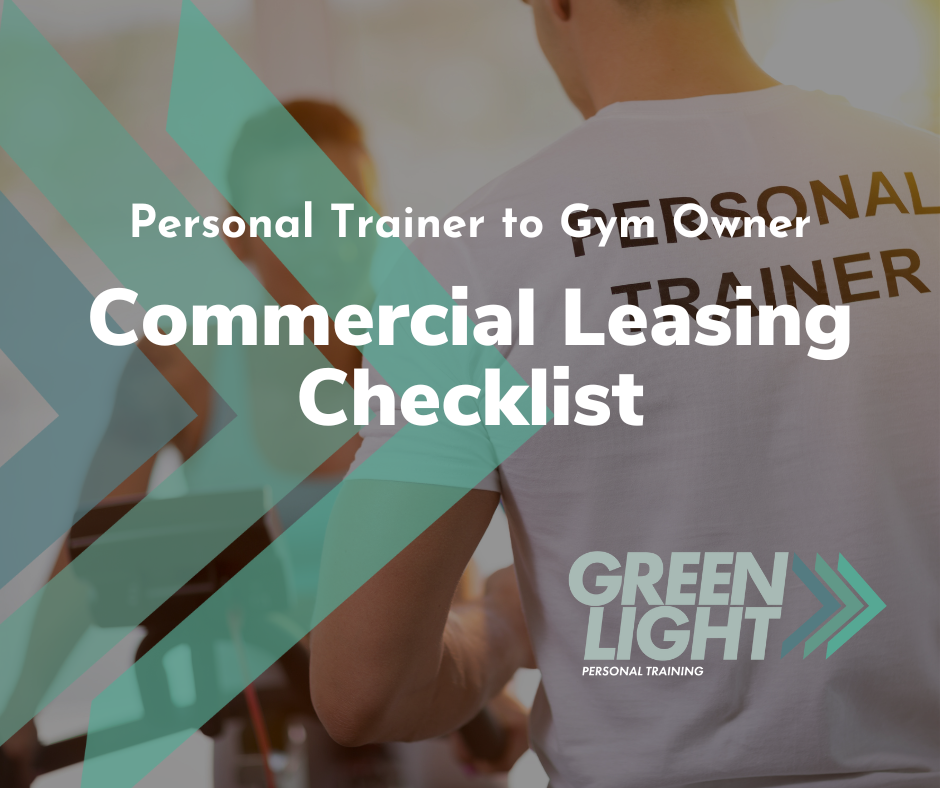
Personal Trainer to Gym Owner: Leasing Checklist
As a personal trainer, you probably don’t know much about commercial leases, that’s okay. This blog will give you some insight into some of the key components to educate yourself on before seeking out a lease for your gym.
The monthly cost of a lease is going to be one of your largest fixed costs for your gym so ensuring you find the right space, under the right deal that will meet the needs of your business now and in the short term future.
The characteristics of the ideal space will depend on the model. For a personal training studio, 1000-1500 sqft will be optimal. The balance between finding an accessible location for clients, a compatible layout to your training model and keeping monthly expenses manageable is what can make or break your business before you even open your doors. While having a gym on the busiest street in your town will be great for acquiring new clients, it will also be a much greater expense each month. Use a qualified real estate agent to help search and negotiate your lease.
Once you’ve worked with a realtor to find the ideal space the next step is to negotiate the lease. The following is a list of key components of a lease agreement that need to be considered in the negotiation process.
Lease Term
The duration of your lease should match the future outlook of your business. You should ask yourself, is this a pit stop before finding a bigger or more visible location? Or do you plan to be in this location for a long time? With new start up gym studio’s, shorter term leases will be optimal to allow for more flexibility. In general, however, longer term leases will usually provide a more friendly lease agreement.
Typical lease terms are 3, 5 and 10 years.
Renew Options
Option to renew is a typical component of a lease that provides the tenant the ability to renew the lease at the end of their current agreement at an agreed upon price point or at current market rates.
The option to extend or renew provides the tenant leverage at the end of their term, and ensures the landlord does not seek a replacement tenant.
Total Rent Costs
It’s important to understand the different terms associated with rent.
Net Rent: Excludes any building costs
Effective Rent: Is the amount after factoring things like a rent free period, build out costs, and/or rent abatement.
Gross Rent: Includes TMI (Taxes, Maintenance, and Insurance)
When evaluating the rent cost, it’s important to be clear about additional monthly costs associated to the building and unit, and who is responsible to pay for them.
Tenant Improvements
Most gym spaces will require a build out including changerooms,showers, office area etc.. The lease negotiation will determine how much will be covered by the landlord and how much will be covered by the tenant. There are a couple different ways to negotiate this, such as Gross Rent free periods, Net Rent free periods, or even rolling the cost of the improvements into the monthly rent over the course of the term
Property Maintenance
Often overlooked is ensuring the tenant is clear about who is responsible for the maintenance of the building premises. This can include things like fixtures, fittings, landscaping etc.. If left to the tenant, it creates additional expenses that can;t be overlooked.
Return to Original Condition
(Make Good Clause) This is a clause in a lease that requires the tenant to return the space to it’s original condition once the lease complete. This can obviously become an additional future expense, and if required by the landlord might affect the negotiation for tenant improvements.
Permitted Use Clause
Your business might change over time. You may also have opportunity to sub lease at some point. Ensuring that the terms of the permitted use is as broad as possible will save you from any restrictions in the future.
Signage
Ensuring that your business is visible starts with signage. When negotiating a lease you must factor in where and how many signs you are able to fix to the building. Additionally, do the signs need to adhere to a certain design to fit the building aesthetics.
Lease Exit
Understanding and negotiating an early termination provision in the lease will help provide flexibility as you grow your new gym. Often times there are fees associated with this type of provision, but it does provide a critical safety net.
If you’re unsure that gym ownership is the best path for you to take as a personal trainer check out our previous article Starting a Fitness Business – What’s the Best Path to Take?
For more information about Greenlight Personal Training Franchises or guidance on transitioning from a personal trainer to a gym owner, contact us franchising@glpersonaltraining.com
